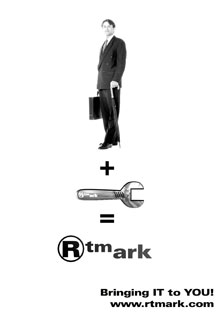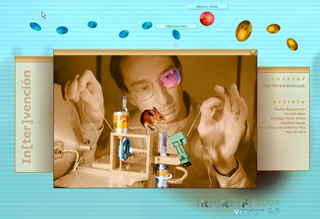Originally printed in the July-September 2006 issue of Afterimage
 The 1990s were a fabulous time for opportunists, visionaries, and entrepreneurs. With the advent of the Internet and the World Wide Web, the potential to communicate with a global audience, with relatively little expense appealed to many. While a number of people wanted to get in on a piece of the action by creating a start-up or at least investing in one, there were some artists, visionaries, and activists who saw the Web as a democratizing force—an opportunity to give the “little guy” a voice and find a global audience for their special interests.
The 1990s were a fabulous time for opportunists, visionaries, and entrepreneurs. With the advent of the Internet and the World Wide Web, the potential to communicate with a global audience, with relatively little expense appealed to many. While a number of people wanted to get in on a piece of the action by creating a start-up or at least investing in one, there were some artists, visionaries, and activists who saw the Web as a democratizing force—an opportunity to give the “little guy” a voice and find a global audience for their special interests.
A widely known art activist group that began using the Internet as its tool of communication in the 1990s is the anonymous collective named RTMark (also known as ®™ark, and pronounced “art-mark”). The group uses the Internet and the Web as a platform to raise awareness of social and corporate injustices, to build community, and ultimately to foster change. The group’s Web site acts as a clearinghouse for tactical media projects. The RTMark site (www.rtmark.com) touts, “Since 1996, the RTMark brand has accrued value by providing key services to artists, activists and the intellectual community. The RTMark system supports the incubation of cutting-edge cultural ventures, while providing a unique opportunity for private investors to sponsor these activities.”(1)
One of the most notable projects that RTMark has engaged in is the Yes Men’s World Trade Organization (WTO) parody site, www.gatt.org. The site, launched in early 2000, looks almost identical to the WTO’s official site but has been modified to generate critical discourse about the policies and proposals of the WTO. The site spawned invitations to attend conferences by visitors who thought that they were conferring with the actual WTO, which the Yes Men accepted. The resulting outcome can be seen in the documentary The Yes Men (2003) by Dan Ollman, Sarah Price, and Chris Smith, who follow the activists’ antics as they act as spokesmen for the WTO.
I recently met with “Max Kauffman,” one of the RTMark members who joined RTMark six months after its founding in 1996. Kauffman, like other members, prefers to remain anonymous and goes by this pseudonym. Initially, Kauffman became interested in the idea of art as an activist tool after being frustrated by his experiences as an employee of a multinational corporation. Kauffman was concerned with the increasingly materialistic culture and growing margin between people and profit. According to Kauffman, RTMark was built by a network of artists, classmates, and activists who found one another at the rise of the Internet in the mid-1990s.
Despite the eclectic projects, RTMark’s tactics are clear. Kauffman asserts, “We come from the tradition of Jonathan Swift and A Modest Proposal [1729]—the idea of couching sharp social commentary in the guise of satire.”(2) An important project RTMark completed in 1999 was aiding an Austrian art group, etoy, in a lawsuit filed by eToys.com over the use of the domain name www.etoy.com. EToys claimed the Web site www.etoy.com was hurting their sales. Linked by the Internet community, which made the debate international news, an outpouring of support helped etoy get their domain back, and the arts organization is still in existence today. The Internet helped RTMark achieve its goal of promoting and aiding activists’ projects. As Kauffman says, “RTMark is a clearinghouse for ideas of resistance to corporate abuses of power. I don’t think RTMark could have existed without the rise of network culture.”(3)
 In Cologne, Germany, Agricola de Cologne uses the Internet to create thematic social sculptures. By linking to other artists and curatorial projects, de Cologne builds community with like-minded thinkers. As a result, he has created what he describes as, “a dynamic network including countless projects, artists, curators, institutions, and organizations; without them, my work would not exist.”(4) He began as a painter, moved into installation, and then shifted his production exclusively to the Internet at the beginning of 2000. De Cologne introduced a collective approach to his art production as an artist/curator/director with such projects as “A Virtual Memorial” (2000) and “Le Musee di-visioniste” (2000), both a part of his NewMediaArtProjectNetwork (http://nmartproject.net/). He describes the NewMediaArtProjectNetwork as “a gigantic dynamic artwork consisting of subordinated networking constructions as projects and subprojects.”(5)
In Cologne, Germany, Agricola de Cologne uses the Internet to create thematic social sculptures. By linking to other artists and curatorial projects, de Cologne builds community with like-minded thinkers. As a result, he has created what he describes as, “a dynamic network including countless projects, artists, curators, institutions, and organizations; without them, my work would not exist.”(4) He began as a painter, moved into installation, and then shifted his production exclusively to the Internet at the beginning of 2000. De Cologne introduced a collective approach to his art production as an artist/curator/director with such projects as “A Virtual Memorial” (2000) and “Le Musee di-visioniste” (2000), both a part of his NewMediaArtProjectNetwork (http://nmartproject.net/). He describes the NewMediaArtProjectNetwork as “a gigantic dynamic artwork consisting of subordinated networking constructions as projects and subprojects.”(5)
Much of de Cologne’s work is a result of concern for what happened during the Nazi regime and World War II. In 1995, at the commemoration of the fiftieth anniversary of the end of WWII, he began a project that reflects the past and present and contributes to the German reconciliation with the Jews and the people of Poland. The resulting project, “1000 years 50 years and still so terribly young” (1995), which he asserts “relates to the historical Nazi ideology of Hitler and its neo-fascist manifestations nowadays,”(6) was a successful show that was included in ten Polish museums, among them the state museums of Auschwitz and Majdanek. Building on the concepts of this exhibition, which pre-dates his Internet work, de Cologne completed another installation, “A Living Memorial—Memorial Project Against the Forgetting, Racism, Xenophobia and Anti-Semitism” (1995), which was shown in the Czech Republic, Germany, and Poland.
De Cologne became concerned with this subject because it was absent from much of his formal education. He writes,
During the nine years in school, I never had any lesson about this historical period. People in 1950s Germany focused on other priorities such as reconstructing living structures and rebuilding a healthy economy. As for cultural concerns, there was no time and no money and no consciousness. People of my generation grew up without a significant understanding of the Holocaust. Of course, this does not mean that there were no publications about the period, or that the press did not report about trials connected with Nazi crimes etc., but most people closed their eyes and ears. I became aware of my history particularly by visiting the countries of Eastern Europe after 1989.(7)
“A Living Memorial” was a success, but it did not come without consequences: the installation was brutally vandalized three hours before the exhibition opening.
A series of illnesses forced de Cologne to stop producing art until 1999 when he began focusing his attention on computer-based work and found Flash as a tool that “conforms to [his] ideas and kind of creative working.”(8) During this time, he became entrenched in digital media, which he believed best complimented his way of thinking.
On January 1, 2000, de Cologne published “A Virtual Memorial—Memorial Project Against the Forgetting and For Humanity” on the Web. At the time of this writing, there are currently six projects online and on view associated with “A Virtual Memorial”: “Memorial for Victims of Terror”; “Memorial for Victims of Aids”; “Tsunami Memorial”; “Family Portrait; Women: Memory of Repression”; and “Memory of the Future.” Even though his work embodies a type of German techno aesthetic that may be off-putting to an American audience, his ideas in regard to collaboration fully utilize the Internet’s networking capabilities for humanitarian purposes.
Since the emergence of the Internet in the 1990s to the general public, artists and social activists have been afforded a new and inexpensive means to create community for social change. RTMark and de Cologne take two radically different philosophical approaches using Internet technology for humanistic purposes with RTMark using subversive tactics while de Cologne uses a community building approach. Both, however, are sensitive to the core.
NOTES
1. See www.rtmark.com/rtcom/success/newsroom.
2. Author interview with “Max Kauffman” of RTMark, March 2006.
3. Ibid.
4. Author e-mail interview with Agricola de Cologne, March 2006.
5. Author e-mail interview with Agricola de Cologne, 2002.
6. Ibid.
7. Ibid.
8. Ibid.
Posted November 2006